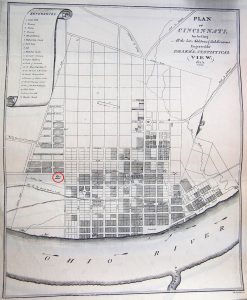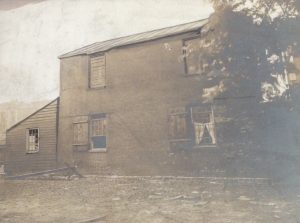In honor of our meeting's 200th anniversary in 2015, Sabrina Darnowsky wrote a book entitled Friends Past and Present: The Bicentennial History of Cincinnati Friends Meeting (1815–2015). To help people become more familiar with our past, sections of this book are being posted via the online Traveling Friend. You can obtain a copy of the printed book or a Kindle version from Amazon.com. The proceeds of all sales go to the meeting.

During the summer of 1813, more than 24 Quakers in Cincinnati pooled their resources to purchase from Nicholas Longworth a hewn log building on the far west side of town, in an undeveloped area south of Fifth Street and west of Western Row (which is now Central Avenue). The building and lot—100 by 150 feet, or about a third of an acre—were initially purchased for $618.
According to most accounts, the building had been constructed around 1800 by Peyton Short, who bought land in the area and erected structures with the intention of keeping slaves there. However, when Ohio came into the Union as a free state, he sold his property to Longworth and went to Kentucky.
Mary P. Hart described the building as having two front doors, as well as “one on the north opening into the men’s side, the other on the south leading out of the women’ side. The interior was very large and commodious.”
Cincinnati Friends spent an additional $215.61 ¾ for “fitting” the structure, perhaps for benches, a table and chair for the clerk, notebooks in which to keep records, a wood-burning stove, or other necessary items. However, in the Quaker tradition, there would have been no altar, no pulpit, no stained glass windows, no crosses or other religious symbols.
Clarissa Gest, whose family joined Cincinnati Monthly Meeting in 1818 when she was three years old, recalled that “the back seat near the entrance was rather elevated and was occupied by the children and their attendants, as some of the latter were colored, they created quite an interest in some of us children who were not accustomed to the latter race.”

There would also have been one or more facing benches, which were directed toward the other benches in the worship room. These were typically used by individuals who often spoke during worship, including any ministers, Elders, traveling Friends, or others.
By the spring of 1814, Cincinnati Friends deemed it necessary to enlarge the existing log building. Longworth sold them an additional 10 feet of land to the east of the original lot, 50 feet to the west, and 50 feet to the south, bringing the total size of the lot to about three quarters of an acre. They subsequently built a framed addition on the east side of the structure and a sliding partition to separate the areas where the men and women conducted administrative matters separately. This meetinghouse provided the community with a home as it prepared for the next phase of its development: becoming an officially recognized monthly meeting.


I like the idea of sharing info like this. Although I have the book, seeing it here is a reminder of our history!
Thanks for posting the history in the Traveling Friend and I look forward to future issues.